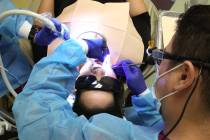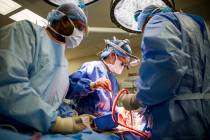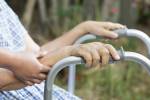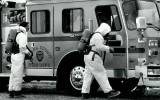Just a kid, but already fighting cancer
She must have taken a tumble, just like all little ones do.
That's what Jerad Ewing thought when his 3-year-old daughter, Ava, complained of soreness in her hip area.
There wasn't even a mark that might develop into a bruise, so the father didn't think much of it.
He picked her up, kissed her on the cheek, gently rubbed her leg.
"It's all better now," he whispered in her ear.
If only that were so.
What that soreness she first experienced in 2010 turned out to be was Stage 4 neuroblastoma, a rare and often deadly form of childhood cancer.
Pain had radiated to her upper leg from a tumor in her abdominal area.
"I didn't want to believe it then," Jerad Ewing says as looks at Ava, who's now 4 and in a hospital bed at Sunrise Children's Hospital. "I don't want to believe it now."
But Ewing and Ava have to deal with the reality of a cancer that only recently saw its survival rate climb to 60 percent.
Chemo. Surgery. Radiation. Bone marrow transplant. Injections. Transfusions. Vomiting. Fever. Infections. Diarrhea. Weight loss. Nosebleeds. Dozens of hospital stays.
When the pain really hits, she gets a morphine drip.
There's more treatment to come for the tiny girl who's no taller than a yardstick, who's so happy that her light brown hair grew back after chemotherapy.
Traces of cancer remain inside her, residue that can cause a deadly relapse. So Dr. Ron Kline, a pediatric oncologist who's been overseeing Ava's care, has her on a new treatment available for the cancer, which strikes about 700 children in the United States each year.
"Dr. Kline has really given me hope," says Jerad, an unemployed union carpenter who's using Medicaid money to pay for his daughter's health care treatment. "I haven't been sleeping too well, but I'm sleeping better now."
Medication sometimes makes Ava sleep more than half the day. Right now, her pretty brown eyes droop behind large oval glasses. She's too tired to talk. In about an hour, Kline will see Ava again.
"You can see from the article in the New England Journal of Medicine that antibody treatment really works," Kline says as he walks through the Comprehensive Cancer Centers offices that adjoin the hospital where Ava is treated. "The reason I love what I do is we keep finding new ways to help kids."
Kline explains that though Ava's immune system makes antibodies to attack germs such as bacteria or viruses, it will not attack neuroblastoma because it is now part of her body. But scientists have found a way to create an antibody in a lab -- which is given to Ava intravenously -- that circulates in the bloodstream until it finds and attaches to a neuroblastoma cell.
And then Ava's own immune system, which Kline stimulates with other agents, attacks and kills neuroblastoma cells.
In the '90s, the neuroblastoma survival rate was 40 percent lower than it is today.
"We haven't hit a lot of home runs with our new drugs," Kline says. "But through research we have hit a lot of singles, so we've scored some victories."
Kline and the team of cancer specialists who work with him are understandably proud that area children can participate in 128 drug trials under way. Sixty-nine children have been enrolled over the past three years.
It is access to new cancer-fighting drugs that Kline often talks about soon after he has to give parents a cancer diagnosis.
"I know what I am giving them is devastating news," he says. "It's extremely difficult. But I can tell them that the new treatments we are coming out with can help their child live."
There have been heartening breakthroughs.
Before 1975, fewer than one in two children diagnosed with cancer survived five years. Today, more than 80 percent of children diagnosed with cancer survive at least five years.
And health officials estimate today that there are 250,000 childhood cancer survivors in the United States and that 1 in 570 "young adults" is a survivor of childhood cancer.
Still, Kline says he must go to too many funerals of his young patients.
"We still have a lot of work to do," he says.
Separated from his wife, who takes care of their 6-year-old son, Jerad Ewing continually prays that enough work on childhood cancer has been done to keep Ava alive.
"I try to focus on the fact that 60 percent of the kids with neuroblastoma survive," he says. "I can't think about the 40 percent who don't. I just can't."
Paul Harasim is the medical reporter for the Las Vegas Review-Journal. His column appears Mondays. Harasim can be reached at pharasim@reviewjournal.com or 702-387-2908.























